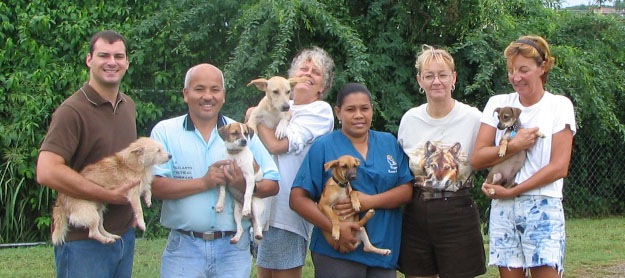 In my ‘other’ life I organize active, outdoor & cultural adventures. Years ago a teacher approached me and asked about organizing a trip for her students to Puerto Rico where they could be immersed in a Spanish speaking culture.
In my ‘other’ life I organize active, outdoor & cultural adventures. Years ago a teacher approached me and asked about organizing a trip for her students to Puerto Rico where they could be immersed in a Spanish speaking culture.
My partner and I decided to visit the islands of Puerto Rico, Culebra and Vieques to see what sort of itinerary we could put together. The beaches were gorgeous, the people were friendly, the food was tasty and the carcasses of dogs killed by cars bloated in the sun on the sides of the roads. When we ate at open air restaurants kittens weaved through our legs begging for scraps. Homeless, diseased dogs, languished in the shade of parked cars and foraged for food in vacant lots. Packs of dogs straggled out of the forest where groups of picnickers tossed them their rubbish. I saw Siberian Husky pups for sale in the window of a pet shop.
On the island of Vieques there are descendants of the horses brought over from Spain called Paso Finos. When you see a herd of them grazing along the beaches it seems idyllic but the reality is stark. These are wild horses living on an island with little access to fresh water and only coarse scrub for them to eat. They starve, become dehydrated, are hit by cars, get tangled in barb wire and fall into crevasses and holes where they die unless someone notices and summons help. As I went from hotel to hotel looking at potential accommodations, I mentioned to someone that I did not think I could return to these islands, what I was seeing was not conducive to any sort of holiday I’d want to take. I was told to find ‘Penny Miller at the Seagate Hotel‘.
When we first arrived at the hotel Penny wasn’t there, but I was given a tour by her father who apologized for his daughter’s absence, she was out tacking up posters for a vaccination drive the local animal shelter/clinic was hosting. Even on this small island measuring just 5 x 21 miles, hundreds of dogs, cats and horses were struggling to survive and Penny, along with others, had noticed. The question that had been going through my mind since I had arrived in Puerto Rico, “Why isn’t anyone doing anything?” was answered, someone was.
I return regularly to Puerto Rico with groups and include a visit to the Vieques Humane Society where students can walk dogs, play with cats, bathe puppies and even pick up poop in the dog yard (only if they’re lucky I tell them). We donate money and 2 dogs returned to New England with teachers who gave them loving homes. Over 100 dogs found forever homes here in Vermont through an adoption program at my local humane society. The people in Puerto Rico are stepping up to the plate and having their dogs spayed and neutered and using preventative treatments to protect their pets from common diseases such as heartworm. But the conditions homeless animals on the islands face remain dire.
Pet shops in San Juan and other cities get regular shipments of dogs from puppy mills in the United States. It is these dogs which continually add to the breeding population  of strays, called satos by Puertoriqueños. There are people in Puerto Rico who care and who have devoted their lives to making a change for animals on their island. They need our help. We can help by donating money, we can help by contacting the group Save-a-Sato when we vacation on Puerto Rico and help them transport dogs back to the States for adoption. We can help by shutting down the puppy mills in the U.S. that supply dogs to pet shops in the Caribbean.
of strays, called satos by Puertoriqueños. There are people in Puerto Rico who care and who have devoted their lives to making a change for animals on their island. They need our help. We can help by donating money, we can help by contacting the group Save-a-Sato when we vacation on Puerto Rico and help them transport dogs back to the States for adoption. We can help by shutting down the puppy mills in the U.S. that supply dogs to pet shops in the Caribbean.
We can help by supporting the people who witness the misery we can leave behind when our vacation is over. The people who are being the change for the animals they share paradise with.





